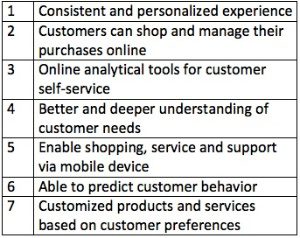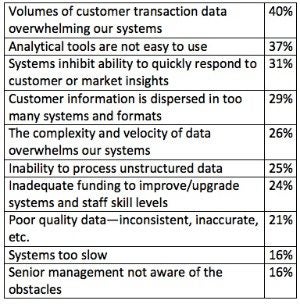Datamation content and product recommendations are
editorially independent. We may make money when you click on links
to our partners.
Learn More
Your marketing department will soon be pushing some new buzzwords down the throat of the IT department. The phrases “customer experience” and “customer centricity” are already commonplace in retailing and financial services, but they’ll soon hit utilities, transportation firms, government agencies and ultimately even B2B.
As the economy slowly improves around the globe, selling more to existing customers is the obvious lower risk approach to increasing top and bottom line growth, hence this focus on getting closer to them.
IT pros, like most other people, have already enjoyed a great customer experience when buying a book or other item from Amazon.com or other gold-standard firm. Fast and reliable service, fair prices, a web site that’s almost always up, that knows what you’ve bought (and are likely to buy) and what others like you have bought, are some of the attributes of a great customer experience. For more insights about the technological underpinnings of a great customer experience, check out this book The Customer Experience Edge. I assisted in the book’s research a few years ago.
To deliver a great customer experience, bankers and other business-to-consumer companies are looking at their operations from the point of view of the customer. Customer centricity means an in-depth knowledge of the customer and the relationship – not just knowing what customers have bought in the past, but what they probably need in the future. A great example from the Staples customer centricity playbook: if you bought an ink jet printer a week ago, you probably need more cartridges.
Some firms are gently and cautiously experimenting with more aggressive – and spooky – analysis that will trigger privacy issues, such as tracking social media discussions, web searches and other indirect shopping efforts, all to better understand and serve the customers.
In a survey and report I worked on late last year, we found the following seven components of customer centricity were considered extremely important by a group of executives and managers from banks and other financial services firms:

The opinions of the 100 bankers included in the survey are in synch with what I’ve heard, read and seen from early adopters among retailers, hospitality and utility companies as well. In addition to sharing the same goals about becoming more customer centric, they share the same obstacles.
It turns out that most organizations may talk the talk of customer centricity, but relatively few can walk the walk. In other words, their reach exceeds their grasp. Our survey found that only half have some of the rudimentary capabilities considered to be the foundation of customer centricity, as this table shows:

Since banking is historically among the most technologically invested industries, it is quite surprising that a third to a half don’t have their own transactions accessible and analyzed to identify ways to provide a better customer experience. While privacy advocates may be alarmed that a third or more banks seem to be gathering and analyzing external data about their customers, providing the right product service at the right price would seem to be a reasonable trade-off.
Let’s face it, now there are few complaints about how much Amazon knows about us. When it first started providing music, book and other recommendations based on our purchase history and related information, it was a bit weird, but I bet most people appreciate the suggestions.
Closing the gap between the level of customer centricity they have now and the level they want to offer presents a variety of challenges. Here are the top 10 IT-related obstacles to delivering customer centricity cited by the bankers, but these issues affect most sectors:

It’s surprising that only 29% complained that data silos inhibited their ability to provide a complete picture of a customer’s current relationship and potential purchases. I thought more than half would cite that perennial concern.
Most companies have a heterogeneous environment, where their enterprise resource planning (ERP) and their Customer Relationship Management (CRM) systems are from different vendors and may not be on speaking terms. In addition, access to those systems is typically limited to individuals in specific departments, so customer service and sales folks may not have access to the accounts receivables modules of the ERP system to know if a customer is a deadbeat before pitching additional sales.
Another big surprise is that three quarters of the respondents didn’t cite unstructured data or the multiplicity of data types as major obstacles. And the fact that three quarters of the respondents didn’t whine about a lack of funding seems to validate the prevailing view that IT spending and budgets are not under lock down.
Which is a good thing, since the solution to many of these obstacles is a Big Data initiative. Done right, it would provide real time, or near real time, processing of the high volumes and varied types of information that need to be processed to deliver customer centricity. And these days, a superfast in-memory database coupled with the right analytics tools can reduce or eliminate many of the obstacles cited by the bankers and experienced by others.
(For more insights about Big Data, including lessons learned by early adopters, check out this prior column, 9 Big Data Lessons Learned.)
So when you hear the marketing department start murmuring about their need to improve the customer experience of your company, you can offer some ideas on how various technologies are considered the prerequisites to help. And if you’re lucky, you’ll get to work with a hot box and new tools that will become increasingly common in a variety of industries.
Photo courtesy of Shutterstock.
-
Huawei’s AI Update: Things Are Moving Faster Than We Think
FEATURE | By Rob Enderle,
December 04, 2020
-
Keeping Machine Learning Algorithms Honest in the ‘Ethics-First’ Era
ARTIFICIAL INTELLIGENCE | By Guest Author,
November 18, 2020
-
Key Trends in Chatbots and RPA
FEATURE | By Guest Author,
November 10, 2020
-
Top 10 AIOps Companies
FEATURE | By Samuel Greengard,
November 05, 2020
-
What is Text Analysis?
ARTIFICIAL INTELLIGENCE | By Guest Author,
November 02, 2020
-
How Intel’s Work With Autonomous Cars Could Redefine General Purpose AI
ARTIFICIAL INTELLIGENCE | By Rob Enderle,
October 29, 2020
-
Dell Technologies World: Weaving Together Human And Machine Interaction For AI And Robotics
ARTIFICIAL INTELLIGENCE | By Rob Enderle,
October 23, 2020
-
The Super Moderator, or How IBM Project Debater Could Save Social Media
FEATURE | By Rob Enderle,
October 16, 2020
-
Top 10 Chatbot Platforms
FEATURE | By Cynthia Harvey,
October 07, 2020
-
Finding a Career Path in AI
ARTIFICIAL INTELLIGENCE | By Guest Author,
October 05, 2020
-
CIOs Discuss the Promise of AI and Data Science
FEATURE | By Guest Author,
September 25, 2020
-
Microsoft Is Building An AI Product That Could Predict The Future
FEATURE | By Rob Enderle,
September 25, 2020
-
Top 10 Machine Learning Companies 2020
FEATURE | By Cynthia Harvey,
September 22, 2020
-
NVIDIA and ARM: Massively Changing The AI Landscape
ARTIFICIAL INTELLIGENCE | By Rob Enderle,
September 18, 2020
-
Continuous Intelligence: Expert Discussion [Video and Podcast]
ARTIFICIAL INTELLIGENCE | By James Maguire,
September 14, 2020
-
Artificial Intelligence: Governance and Ethics [Video]
ARTIFICIAL INTELLIGENCE | By James Maguire,
September 13, 2020
-
IBM Watson At The US Open: Showcasing The Power Of A Mature Enterprise-Class AI
FEATURE | By Rob Enderle,
September 11, 2020
-
Artificial Intelligence: Perception vs. Reality
FEATURE | By James Maguire,
September 09, 2020
-
Anticipating The Coming Wave Of AI Enhanced PCs
FEATURE | By Rob Enderle,
September 05, 2020
-
The Critical Nature Of IBM’s NLP (Natural Language Processing) Effort
ARTIFICIAL INTELLIGENCE | By Rob Enderle,
August 14, 2020
SEE ALL
APPLICATIONS ARTICLES










